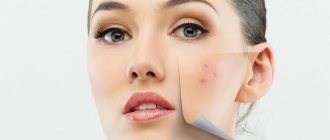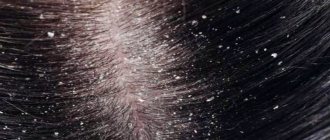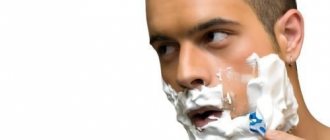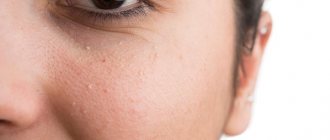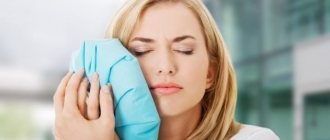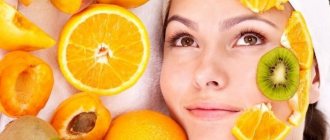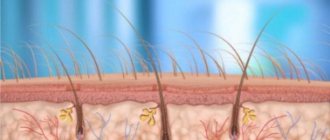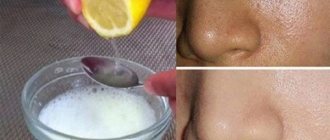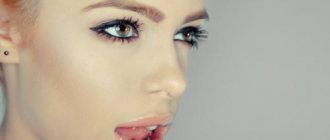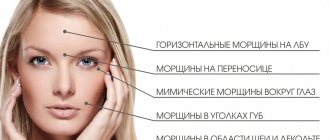Acne can bother a person regardless of his gender, age and lifestyle, but most often they appear during adolescence, when hormonal changes in the body occur.
Skin rashes, especially if they appear on open areas of the body, cause not only physical discomfort, but can also cause infections and the development of various diseases.
Depending on the degree of damage and localization of teenage acne, you can use cosmetics to improve the condition of the skin or medications prescribed by a dermatologist.
This article discusses in detail all effective techniques that can reduce the number and severity of rashes.
What causes acne on a teenager's face?
Acne can occur for many reasons. The most common are the following:
- Unbalanced diet, deficiency of vitamins and other nutrients in the body.
- Increased androgen levels.
- Disturbances in the functioning of the endocrine system.
- Diseases of the gastrointestinal tract.
- Subcutaneous Demodex mite.
Before you try to get rid of acne for a teenager, you need to find out the reasons for its appearance. Very often, demodex mites can settle in the sebaceous glands, which can only be gotten rid of with the help of medications. - Improper skin care.
- Failure to comply with hygiene rules.
- Taking medications.
- Frequent stress and overwork.
- Inflammatory processes in the body.
- Genetic predisposition.
Teenagers' skin is particularly sensitive, so eating certain foods can trigger inflammation.
Causes of acne in teenagers
At the age of 11-12 years, hormonal changes begin in the child’s body, and the reproductive system is formed. Against the background of imbalance, the work of the sebaceous glands increases, and more sweat is produced. In a humid environment, pathogenic microbes actively multiply, which provoke an unpleasant odor, the appearance of pimples, acne on the face, back, and chest. Most often the face is affected - cheeks, forehead, chin, nose.
The formation of rashes can be strengthened and complicated by:
- lack of proper hygiene;
- dusty area;
- wrong choice of cosmetics;
- chronic diseases of internal organs;
- unbalanced diet - a lot of sweets, fatty, spicy foods;
- frequent use of medications;
- disruption of the thyroid gland, which is responsible for the production of hormones;
- stress, emotional stress.
As the hormonal levels are restored, the skin clears, the condition improves, and the rashes disappear. If severe acne develops, treatment is required, since the lack of proper measures leads to the formation of loose skin, uneven tone, and scars.
Degree of acne damage
How to get rid of acne on a teenager’s face depends on the severity of the disease. Treatment is selected depending on the stage of acne.
- Stage 1. Mild acne. White or black comedones, called blackheads, appear on the face. Their number can reach 10 pieces. There are no signs of inflammation at the site of the comedone, the skin in other places remains clean. At this stage, acne is not a cause for concern. Comedones in adolescence in most cases appear due to hormonal changes.
- Stage 2. Moderate acne. At this stage, the number of comedones increases, and as the disease progresses, they take the form of papules. Their number ranges from 10 to 25 units. The skin at the sites of their formation becomes red or bluish. Comedones can become inflamed and turn into pustules with purulent contents. At this stage, the teenager requires treatment, as the acne will not go away on its own.
- Stage 3 . Severe acne. The number of comedones and pustules increases to 50 pieces. At this stage, acne takes on a cystic or keloid form, and scars form. The skin becomes inflamed and acquires a purplish-red hue. The skin is affected in the deep layers, scars remain for a long time.
- Stage 4. Extremely severe acne. Acne progresses to this stage if there was no treatment in the early stages. The number of inflammations on the face becomes more than 50. Papules and pustules connect with each other, forming nodes. The skin becomes painful on contact. At this stage, large BCs form, which are difficult to treat.
Causes of acne in adolescence
The reasons for the appearance of acne in adolescents lie in the systemic restructuring of the body, which begins when the child reaches puberty. The main one is genetic predisposition. If your parents had facial problems as teenagers, then you are more likely to have them too.
Elena Malysheva, a well-known TV presenter of a program dedicated to health, calls a “hormonal storm” the main reason for the appearance of acne. Hormone changes in turn lead to the following factors that influence the appearance of acne:
- increased synthesis of sebaceous glands and increased keratinization of the epidermis, which generally clogs the pores;
- an increase in the frequency of pathogenic inflammatory processes on the face and body.
The development of the disease in young men is further aggravated by increased testosterone levels, which is why the 2 above factors are felt much more strongly.
Additional causes of acne in adolescents account for a maximum of 20% of the total mass:
- Stress, emotional overload, complexes;
- Constant consumption of salty, fried and fatty foods;
- Addiction to fast food, smoked meats, sweets, especially chocolate;
- Too much coffee;
- Failure to comply with facial hygiene rules;
- Unsuitable care products;
- Excessive use of decorative cosmetics;
- Lack of vitamins;
- Long-term drug therapy;
- Diseases of infectious etiology;
- Diabetes of any type;
- Environmental influence – high humidity, high level of air pollution;
- Mechanical irritation - rubbing the skin with your hands, tight collars, synthetic tight-fitting clothing.
How to choose treatment
It is possible to get rid of acne on a teenager’s face at any stage, but to do this you need to know how to choose the right treatment.
When choosing preparations for external use, it is worth considering your skin type. The same rule must be followed when using cosmetics. For oily skin types, cosmetics are selected with a drying effect, and for dry skin - with a moisturizing effect.
In addition, it is worth considering the stage of acne. In the initial stages, external remedies and proper care are sufficient. In difficult stages, you cannot do without internal medications. Before you start taking medications, you must undergo an examination.
In severe stages, radical measures are used. Laser techniques are used; in extremely advanced cases, surgical intervention may be required.
Cosmetic procedures are selected taking into account your skin type and its needs. Mesotherapy is used to eliminate inflammation, and ozone injections are used to eliminate scars.
How to understand that the body lacks vitamins
The causes of acne can be hormonal disorders, complications of drug therapy, hereditary predisposition, poor diet and deficiency of nutrients. In women, acne and spot inflammation can occur during the premenstrual period and during pregnancy.
A lack of vitamins is manifested by the following symptoms:
- grayish, dull skin color;
- blackheads on the face and body (open comedones);
- age spots;
- cracks in the corners of the lips (jams);
- dry mucous membranes (eyes, mouth);
- white and reddish rashes;
- itching, irritation, peeling of the skin;
- frequent appearance of bruises, circles under the eyes;
- signs outside the skin: indigestion, nausea, muscle cramps, decreased visual acuity (night blindness), dandruff, hair loss, dry and brittle hair, yellowing of nails, the appearance of longitudinal stripes on the nail plates.
Most often, acne appears in areas rich in sebaceous and sweat glands: on the face, chest, back and scalp.
The cause of acne on the face can be either a hormonal imbalance or a lack of vitamins and microelements.
Teen cosmetics
How to get rid of acne on a teenager’s face and what cosmetics to use is of interest to many. Currently, there are many manufacturing companies producing products for skin treatment. Its action is aimed at eliminating inflammation, evening out skin tone and eliminating acne spots.
It is recommended to regularly use cream, mask and gel for washing.
1. Anti-inflammatory face cream from Mixit. The product is intended for oily and combination skin types. It helps maintain balance, but is not moisturizing. Has an antiseptic and regenerating effect.
It contains many useful components:
- St. John's wort oil.
- Aloe vera.
- Soybean oil.
- Vitamin E.
- Calendula extract.
- D-Panthenol.
- Rosemary essential oil.
- Chamomile extract.
- Jojoba oil.
- Azelaic and glycolic acid.
- Vegetable Shea butter.
The cream eliminates redness and irritation, and also relieves discomfort. It should be used regularly and can be used as a base for makeup. The average cost is 500 rubles.
2. Soothing alginate mask Riche. Has a quick effect. Restores skin, eliminates irritation and redness. In addition, the mask quickly dries out inflammation and reduces the likelihood of new ones appearing. Promotes cell renewal and accelerated regeneration of the epidermis. Increases the protective properties of the skin.
Composition of the product:
- Coconut oil extract.
- Sea fennel.
- Brown algae.
- Aloe vera.
- Sodium alginate.
- Vitamin E.
- Polysorbate 20.
- Chromium oxide.
- Sunflower oil.
It is recommended to use the mask 2-3 times a week. It must be applied in a thick layer to the face, then removed using upward movements. Average cost: 490 rub.
3. La-Roche Posay cleansing gel. Promotes gentle removal of sebum, cleanses pores and has an antibacterial effect. Suitable for sensitive skin. Effectively removes makeup and impurities. Recommended for skin that is prone to inflammation.
The gel contains the following main components:
- Thermal water.
- Laureth sulfate.
- Zinc pidolate.
- Cocamidopropyl betaine.
It is recommended to use 2 times a day. The average cost is 900 rubles.
Don't miss the most popular article in the section: Face fitness for facelift, rejuvenation, muscle tone. Master class from Elena Karkukli
Internal admission rules
With proper intake of vitamins orally, the condition of the skin and the functioning of the body improves significantly. Incorrect dosage can be harmful, cause an allergic response, diarrhea, and high blood pressure.
A+E
Before using retinol and tocopherol for acne internally, you should read the instructions or consult a doctor. The technique comes down to simple rules:
- Drink in the morning after breakfast containing vegetable or animal fats.
- Do not use on an empty stomach.
- It is better to take the capsule 30 minutes after eating.
- You should not take medications with juice, milk, or coffee. Drinking water is suitable for this.
- Regular use is mandatory so that the required dose of the drug is present in the body every day.
- Capsule medications must be swallowed, chewable tablets must be chewed.
- You need to take vitamin complexes in a course, each of which is 30 days, and then take a break.
- You can learn more about the acceptable dosage when treating acne in adults, adolescents and pregnant women by asking your doctor and taking blood tests.
Drugs combining A and E in one tablet are presented by the names:
- Aevit;
- Vitaminel;
- VitAE.
It is not necessary to resort to taking synthetic vitamins. There is a lot of tocopherol and retinol in food:
- beef meat and liver;
- vegetable oil, butter;
- dairy products;
- herring, halibut;
- cereals;
- red, green vegetables, herbs;
- legumes;
- flax seeds, rose hips.
A well-structured diet will become part of the treatment and will help get rid of acne on the face and body. For those whose rhythm of life does not allow them to eat properly every day and involves snacking, it is preferable to replenish vitamin reserves with the help of a synthetic analogue.
Ascorbic acid
Vitamin C for acne is taken twice a day - in the morning and in the evening, an hour after meals. It is recommended to take the tablets with water. In addition to the well-known ascorbic acid, synthetic analogues “Ascovit” and “Citravit” are popular.
A large amount of useful elements contain:
- berries: sea buckthorn, currant, viburnum, cranberry;
- citrus; bell pepper;
- leafy vegetables: cabbage, spinach.
The consequences of an overdose of ascorbic acid are not as terrible as the previous ones. The most unpleasant of these are itchy skin and, rarely, diarrhea.
Group B
The complex of B vitamins for oral administration is called “Pentovit”. It is presented in full composition, which makes it possible to classify it as a complete drug for the treatment of acne. One tablet contains:
- B1 – thiamine;
- B6 – pyridoxine;
- B9 – folic acid;
- B12 – cyanocobalamin;
- B3 – niacin (nicotinic acid).
Alvitil, Vetoron, and Aerovit also fight rashes.
These vitamins against acne on the face are found “live” in foods such as nuts, legumes, meat, salad vegetables, and brown rice. The most effective of them, B3, is most concentrated in mushrooms, liver, and beans.
Retinoid ointments
Retinoid ointments are highly effective. They are recommended for severe stages of acne. Currently, the range of such ointments is quite wide. They all have a similar principle of action and composition.
| Drug name | Description | Compound | Price |
| Retinoic ointment | Participates in the process of cell division, reduces the stratum corneum of the skin. It also reduces sebum production and heals existing acne. | Isotretinoin, emulsion wax, ethyl alcohol, glycerin, water, petroleum jelly. | 280 rub. |
| Differin | Able to penetrate into the deep layers of the epidermis. Has a pronounced drying and anti-inflammatory effect. The result of use is noticeable almost immediately. | Adapalene, carbomer, phenoxyethanol, water, sodium hydroxide. | 650 rub. |
| Retasol | Inhibits the action of the sebaceous glands, thereby reducing the oiliness of the skin. Dries out pimples and prevents the formation of new ones. | Isotretinoin, propylene glycol, ethanol, butylated hydroxytoluene. | 430 rub. |
Antibiotic for oral administration
Products to reduce sebum production. Preparations based on retinoic acid are widely known - Adapalene, Tretinoin, Roaccutane, retinoic ointment.
Boys' androgen levels constantly increase as they grow up, so they need acne treatment much more often than girls of the same age.
Modern medicine has many methods for treating teenage rash. The intensity of the course of therapy depends on the number of rashes and the stage of development of the skin disease.
Sometimes the issue of teenage acne resolves itself as the boy grows older, but hoping for this can cause harm to the child’s health and miss the onset of a serious skin disease.
Antiseptic ointments
Antiseptics are indispensable means for treating acne.
| Name | Description | Compound | Price |
| Salicylic ointment | Used for skin inflammation, relieves inflammation and itching. Regular use will help get rid of acne and blemishes. | Salicylic acid, medical Vaseline. | 25 rub. |
| Skinoren | Suitable for the treatment of acne vulgaris and rosacea. Has a pronounced bactericidal effect. | Azelaic acid, water, benzoic acid, triglycerides. | 580 rub. |
| Curiosin | Used to treat complicated forms of acne. Reduces inflammation, evens out skin tone and eliminates scars. | Zinc hyaluronate, water, potassium sorbate, sodium hydroxide. | 480 rub. |
Antibiotics
Antibiotics are used in severe stages of the disease when topical medications have no effect.
- Doxycycline. The active substance is doxycycline hydrochloride. The drug penetrates the cells that caused the inflammatory process. Prevents further spread of inflammation. It has a number of contraindications and side effects. The average cost is 25 rubles.
- Tetracycline . The active ingredient is tetracycline. It has a bacteriostatic effect and eliminates pathogenic microorganisms. Has a pronounced effect against staphylococcus. It is distributed unevenly in the body, most of it is deposited in the liver. To treat acne, the course should be no more than 3 weeks. Price – 50 rub.
- Ampicillin . Has a wide spectrum of action. Among the antibiotics used in the treatment of acne, it occupies a leading place. The result of use is noticeable after a week of use. Average cost – 40 rubles.
Hormonal drugs
Hormonal imbalances are the most common cause of skin problems in teenagers. Therefore, special hormonal drugs are used for treatment.
It is very important to choose the right pills to avoid worsening the situation.
Before starting treatment, you must donate blood to check your hormonal status. Based on this, tablets are selected. To treat acne, hormonal tablets with an antiandrogenic effect are prescribed. Teenagers are recommended to take low-dose tablets such as Yarina or Jess.
Retinoids
A dermatologist will tell you how to get rid of acne on a teenager’s face. In the last stages of the disease, this issue is especially acute. In this case, retinoids are used for internal use.
Taking such drugs for self-medication is strictly prohibited, as they have a wide list of contraindications and side effects, have a teratogenic effect, and are therefore prohibited for pregnant women and those planning a pregnancy in the near future.
The active ingredient of retinoids is isotretinoin. It is synthetic vitamin A. These drugs can cure acne in its most recent stages.
The course of treatment is calculated individually, depending on the patient’s weight and the stage of acne. The average duration of treatment is six months. The first improvements are noticeable after 2 months of use. In the first weeks, an exacerbation of the disease is possible, but you should not stop taking the drug.
During the course of treatment, you should avoid prolonged exposure to the sun and use moisturizers, as the skin will peel off greatly.
The high efficiency is due to the fact that the drug significantly reduces the production of sebum, changing its composition. The sebaceous glands decrease in size and their condition returns to normal.
As a result, the size of the pores decreases and their blockage disappears. In most cases, one course is enough to get rid of acne forever. Among the retinoid drugs, the most famous are Roaccutane, Sotret and Acnekcutane.
Acne appears: what vitamins are missing?
There are substances that the skin needs especially badly. They are also called beauty vitamins. And for good reason. The lack of such microelements really leads to loss of skin attractiveness and the appearance of acne. These vitamins include:
- Tocopherol, or vitamin E. This trace element is a powerful antioxidant that protects the body from the negative effects of external factors. It is necessary for the normal functioning of the heart and muscles, and can protect the nervous system. Tocopherol is especially important for the skin: the substance protects it from drying out, maintains its elasticity and strength. With a lack of this microelement, the immunity of the epidermis weakens, which can result in acne and other inflammations.
- Calciferol. Vitamin D is responsible for the normal absorption of calcium and phosphorus into the blood. In addition, it improves the condition of the skin in psoriasis, accelerates wound healing, protects the epidermis from sunlight, and helps eliminate acne.
- Retinol, or vitamin A, is very useful for the beauty of the skin, hair and nails. This substance normalizes cellular metabolism, as a result of which the sebaceous glands begin to work as usual, acne disappears.
- Ascorbic acid. Vitamin C is a friend of vitamins A and E. When there is a deficiency of this microelement, the skin becomes dull, thin, and the blood vessels become thinner, as a result of which the skin's immunity drops significantly, and this causes the appearance of rashes.
Tips for teenagers - how to improve skin condition
Any dietary supplements containing the substances mentioned are beneficial for the beauty of the skin and help fight acne. However, the site sympaty.net found that some complexes are the most effective against acne. It is proposed to focus our attention on them further.
Homemade acne masks
1. Required components:
- Chicken egg white.
- Freshly squeezed lemon juice.
Preparation:
Mix the ingredients thoroughly, then apply to the face for 15-20 minutes. The mask effectively cleanses pores and evens out skin tone.
2. Required components:
- Liquid honey – 2 tbsp.
- Aspirin – 2 tablets.
Preparation:
Grind the tablets into powder, then mix with honey until smooth. Apply the mask for 25-30 minutes, then rinse with cool water. Use 2-3 times a week. The mask has an anti-inflammatory and moisturizing effect.
3. Required components:
- Chicken egg – 1 pc.
- Granulated sugar – 8 gr.
- Activated carbon – 2 tablets.
- Lemon juice.
Preparation:
Grind the tablets until crumbly. Mix all ingredients, then distribute evenly over the skin. Keep the mask until completely dry, then remove it like a film. Effective for eliminating blackheads and evening out skin color.
Homemade lotions for washing and cleansing skin from acne
1. Bay lotion.
Required components:
- Bay leaf.
- Vodka or alcohol.
Preparation:
Finely chop the bay leaf, place it in a glass bowl, then pour in vodka. Leave to infuse in a dark place for 1 month. Use daily, gently rubbing your face.
2. Cucumber lotion.
Required components:
- Cucumber
- Vodka or alcohol
Preparation:
Turn the cucumber into a pulp, then pour in vodka. Leave to infuse for 2 weeks. Use lotion 1-2 times a day. After use, it is recommended to apply moisturizer.
3. Sage and rose lotion.
Required components:
- Sage.
- Rose.
- Alcohol or vodka.
Preparation:
Cut sage and rose in equal proportions, then pour in vodka. The lotion should infuse for 1.5 weeks. Daily use is not recommended. It is better to apply once every 2 days.
Pharmacy folk remedies
- Salicylic alcohol. Widely used for various skin diseases, including acne. It has a pronounced drying and anti-inflammatory effect. It is recommended to apply locally to the inflammation itself. Promotes rapid healing of pimples without leaving a mark on the skin. In addition, salicylic alcohol has an exfoliating and antimicrobial effect.
- Levomycytin alcohol. It is widely used in the treatment of acne, but long-term use is not recommended, since alcohol greatly dries out the epidermis. You need to apply a small amount to the pimple itself to avoid burning. Contraindicated for sensitive skin. Effective for purulent acne, helps dry them out quickly. Used as a regenerating agent against residual scars.
- Tonics with zinc compounds. They are a very effective product that can be used on sensitive skin. Zinc helps dry out inflammation and lighten the skin. Regular use helps even out the complexion, making it healthier. Zinc acts as an antiseptic and also reduces sebum production.
To get rid of acne, don't do this.
As practice shows, explaining what not to do can be more important than establishing the entire system of care described above. For skin with acne, the following are prohibited:
- Any scrubs , brushes and sponges, even the newest ones. Anything that spreads infection and uncontrollably affects the process of keratinization of the skin will cause harm.
- Alcohol ─ pure, in tinctures, salicylic and similar alcohols, alcohol-based tonics.
- Products with a fatty base ─ any oils, two-phase makeup remover lotions, milk and cosmetic cream for washing, thick foundations. Even if the manufacturer indicated on the bottle that it is for problem skin, you should avoid it.
- Self-cleaning. Keep your hands off your face - this is the main rule! If a child is involved in sports or dancing, then you need to make sure that he always has a clean towel and wet wipes with him during classes. Rubbing your hot forehead with your palm after playing a dirty basketball is definitely not the way to clear skin.
- Intense tan. It doesn’t matter whether it’s a solarium or hot countries - ultraviolet radiation has a detrimental effect on acne-prone skin. First, an imaginary improvement occurs, the inflammations dry up, the complexion becomes smoother, this pleases and encourages new sunbathing. But literally in a couple of weeks the child will become the proud owner of a dozen fresh inflammations, and it can be very difficult to relieve such an exacerbation. The sun is a powerful provocateur.
- Try all the pharmaceutical ointments. The wider the list of products, the worse the skin reacts even to correctly prescribed treatment.
Diet for a teenager with acne
If you manage to remove snacks, sweets (bakery, milk chocolate), all dairy products from your child’s diet and add more greens, fresh vegetables and seafood, then you can already consider that a third of the work is done.
Steam baths
Steam baths are used to cleanse the skin. The steaming effect allows you to open the pores, after which it is easy to remove accumulated dirt and sebum from them. They also help remove the dead skin layer.
Steam facials help enhance the effect of subsequent procedures and cosmetics, as they penetrate much deeper into the epidermis. Steaming promotes the resorption of subcutaneous seals, therefore it is recommended for cystic acne.
It is very simple to do this procedure at home. You need to boil water, then tilt your face over the steam, covering yourself with a towel. To enhance the effect, anti-inflammatory herbs are added to the water. Chamomile and calendula are especially popular. It is recommended to use steam baths 1-2 times a week.
Anti-acne powder
Many dermatologists recommend using a special talker against inflammation. It is easy to prepare, and this product does not require large financial costs. For teenage skin, it is better to use boric acid.
Required components:
- Medical alcohol – 40 ml.
- Boric acid – 40 ml.
- Salicylic acid – 2 gr.
- Levomycytin – 5 tablets.
Preparation:
Mix all the components together, first crushing the tablet into a powder. There is no need to infuse the product; it can be used immediately. It is better to apply a thin layer to inflamed areas of skin at night. It is forbidden to apply completely to the entire face, since the mash has a strong drying effect.
The result is noticeable already in the morning. Inflammations are significantly reduced in size.
Cosmetology procedures
- Peeling. Can be superficial, middle or deep. The latter type is performed in a clinical setting. In a beauty salon, it is better to give preference to medium peels for acne. There are many types; retinoic peeling is better for oily skin, and glycolic peeling for dry skin. The procedure is aimed at relieving inflammation, improving regeneration and restoring the skin. For the best effect, a course of 4-6 procedures is recommended.
- Mesotherapy. Used for severe stages of acne. It is an injection technique. Special preparations are injected deep into the skin, where recovery processes begin. This procedure significantly transforms the condition of the skin. Allows you not only to get rid of acne, but also from stagnant scars. Skin improvement begins gradually within 2 weeks after the procedure.
- Hardware facial cleansing. Cleaning can also be mechanical, but the hardware method is the most gentle. Cleaning allows you to get rid of inflammation of any type, including pustular acne. Particularly effective against blackheads. Allows you to eliminate the stratum corneum of the skin and start regeneration processes.
How to treat acne in teenagers?
Acne in adolescence may manifest itself differently than in adults; the causes of development and the disease may differ, respectively, and treatment methods have their own specifics, which is important to take into account to successfully combat the disease.
Specifics
The main tasks that are solved in the treatment of juvenile acne:
- Softening of comedones and complete elimination of excess secretion;
- Liquefaction of subcutaneous fat;
- Stabilization of the sebaceous and sweat glands;
- Suppression of the activity of pathogenic microorganisms;
- Preventing the appearance of acne marks.
Effective treatment of acne in adolescents is possible using a set of methods, as well as following a number of rules:
- Timely visits to a dermatologist and specialists according to his recommendations. Sometimes acne is a consequence of physical illnesses, and standard treatments will not work;
- Excluding attempts to squeeze out pimples. Mechanical impact on acne leads to aggravation of pathological processes and can provoke sepsis or complications. The likelihood of scar formation also increases;
- Using products designed for acne-prone skin. Gels, soaps, foams containing aggressive antiseptics, alkali or alcohol aggravate the situation. It is effective to use cosmetics based on oils (shea, argan, hemp).
- Avoiding scrubs. Intense mechanical impact irritates the epidermis and causes inflammation. Solid particles are carriers of infection, therefore, the use of a scrub can provoke the formation of ulcers;
- Selecting one remedy. In the desire to quickly get rid of acne, teenagers often use all the products intended for the treatment of acne at once. The result is progression of the disease, it is important to stick to one drug recommended by the doctor;
- Take prescription medications strictly according to the treatment regimen. Violations of the therapeutic course negate the results already obtained; moreover, excessive “indulgence” in the prescribed products negatively affects the skin;
- Complete course of treatment. It happens that after the first improvements occur, boys and girls refuse to continue therapy. This should not be allowed - untreated acne will very soon begin to recur.
The duration of treatment for juvenile acne is 2-3 months, sometimes it can last up to a year (in especially severe situations).
Drugs
Drug therapy for acne in adolescents depends on the severity of the disease, the form of the rash, and the causes. A dermatologist can prescribe external medications, either alone or in combination with oral tablets, to enhance the therapeutic effect.
As for the form of the drug, everything is purely individual and depends not only on the degree of neglect of the disease, but also on the individual reactions of a particular teenager.
Creams, ointments and lotions
Topical pharmaceutical products prescribed to adolescents include ointments and lotions containing antibiotics, pore softening agents, and complex creams containing both active ingredients.
The therapeutic course can last up to a year. All medications must be applied to the skin several times a day, strictly after washing. Possible side effects:
- Sensitivity to sunlight;
- Irritation;
- Feeling of dryness;
- Redness of certain areas of the skin.
The following medicinal cosmetics for acne have proven themselves to be the best:
- Zenerite. Eliminates inflammation and excess fat due to erythromycin and zinc in the composition;
- Dalatsin-T. Cleans pores, dries the surface of the epidermis, reduces the inflammatory process to “no”;
- Skinoren. Reduces the secretion of fat, reduces the growth of cells blocking pores. The active ingredient is azelaic acid;
- Propeller line of medicinal cosmetics. Provides care for skin affected by acne. Relieves inflammation, cleanses the skin. Active ingredients: zinc, cincidone, panthenol, acids, plant extracts;
- Salicylic, retinoic and zinc ointments. Reduce microbial activity and get rid of excess sebum.
Pills
When treating teenage acne, it is effective to use oral tablets containing:
- Antibiotics. Contains doxycycline, erythromycin, tetracycline. Therapy with these drugs is prescribed for severe stages of the disease or moderate acne. Possible side effects - allergies, digestive disorders, vaginal candidiasis, discoloration of tooth enamel;
- Retinoids. Prescribed in exceptional cases when acne is diagnosed as stage 4. Roaccutane and its analogs normalize the activity of the sebaceous glands and fight infection from the inside. The drug can be taken strictly according to the schedule due to serious side effects.
dietary supplements
Topical dietary supplements can be used as an adjuvant in the treatment of juvenile acne, however, the main purpose of herbal remedies in the treatment of acne in adolescents is to saturate the body with mineral and vitamin complexes in case of their deficiency. Dietary supplements enhance the effectiveness of the main treatment and can eliminate minor inflammations.
Dermatologists recommend Acnelocin for boys and girls suffering from acne. The supplement formula contains important components: zinc, retinol, riboflavin, manuka extract, aloe, tea tree, sparulina, chlorella.
The complex effect of active components is aimed at:
- Reducing inflammation processes;
- Elimination of acne and post-acne elements;
- Improved blood circulation;
- Acceleration of skin regeneration.
The visible result is guaranteed by the manufacturer after 10 days.
Folk remedies for teenage acne
Traditional medicine recipes help well with mild acne. In adolescence, grade 3-4 acne is treated only under the supervision of a dermatologist.
Medicines prepared at home are used as lotions and compresses. Decoctions and infusions should be drunk to cleanse the body from the inside. A separate point is made about natural oils as effective means of fighting the disease.
Local remedies
A variety of folk remedies include herbal medicine and food-based recipes. Among them:
- Raspberry herbal tea. Chop and mix the leaves and flowers, pour a cup of boiling water over it, leave for half an hour. Wash with the decoction in the morning and evening;
- Infusion of chamomile and calendula. Mix the flowers of the plants, take 2 tablespoons. Pour in a liter of boiling water. Leave for 40 minutes. The usage pattern is similar to the previous recipe;
- Decoction of sage with honey. Boil 1.5 tablespoons of sage in 200 ml of water. After boiling, wait half an hour. Strain and pour in a teaspoon of liquid honey. Apply lotions twice a day to areas of skin affected by acne;
- Cucumber lotion. Peel and thinly slice 2 cucumbers, place in a glass container, pour in a glass of vodka. Leave at room temperature for 2 weeks. Wipe the skin 2 times a day.
Decoctions and infusions for oral administration
Some homemade herbal remedies are much more effective if the treatment of acne on the face of a teenager is carried out not locally, but by taking decoctions orally according to a certain scheme. Good results are shown by:
- A decoction of dandelion roots. A tablespoon of dry parts of the plant should be filled with 250 ml of hot water. Boil for 15 minutes over low heat and cool. Drink 1/3 glass three times a day before meals;
- Violet infusion. 2 teaspoons of raw materials are poured into 3 cups of boiling water. The product is infused for 2 hours and consumed ½ glass 3 times a day before meals;
- Golden infusion. Pour 1.5 dessert spoons into 200 ml of boiling water. Leave for 1 hour. Drink during the day, divided into 4-5 doses;
- Decoction of nettle leaves. Prepared from 2 cups of boiling water and 2 tablespoons of leaves. Leave for 2-3 hours. Drink 100 ml before meals.
Natural oils
Despite the fact that cosmetic oils are considered quite oily care products, some of them effectively cope with pimples and acne.
The most commonly used oil is coconut oil. Recipes based on it:
- Melt 50 g of dark chocolate and mix with coconut oil in the amount of 1 tablespoon. Apply the composition for 5 minutes. Rinse off with warm water. Apply once every 3 days for 2 weeks;
- Crush the persimmon pulp into puree. Add egg yolk and 1 teaspoon each of oil, cornstarch and honey. Keep the mixture on your face for 15 minutes, rinse with water at room temperature. After the procedure, soften the skin with chamomile infusion.
In second place is calendula oil. Based on it, a hot mask is prepared that allows you to cope with various forms of acne. You can do it as follows:
- Heat a cloth napkin by immersing it in hot water;
- Apply 25 drops of marigold oil evenly;
- Place on your face for half an hour and cover with a towel;
- Wash with warm water.
Vitamins and diet
In adolescence, the prerequisites for the formation of comedones and papules often lie in a lack of vitamins and an unhealthy diet.
The body of high school students is exposed to increased physical, mental and emotional stress, so it is important to maintain the required level of substances:
- Vitamin A. Regulates the natural balance of moisture and the production of skin secretions;
- Vitamin E. Cleanses;
- B vitamins. Protect the skin from aggressive environmental influences;
- Vitamin C. Reduces irritation and reduces inflammation.
Doctors recommend using the following to treat acne:
- Aevit. Restores the protective functions of the dermis and compensates for the lack of vitamins A and E;
- Magne B Contains magnesium and B vitamins. Positively affects the emotional state, reduces the effects of stress;
- Ascorbic acid. Suppresses the activity of infectious agents that provoke inflammatory processes.
The drugs will give the desired result only if taken in a course course. You can also resort to combined vitamin complexes to treat acne. Among them:
- Pikovit;
- Vitrum;
- Alphabet;
- Complivit.
A proper diet plays an important role in getting rid of acne. Meals should be small and exclude snacks. Basic diet:
- Low-fat fish varieties;
- Lean meat;
- Fermented milk products;
- Cereals;
- Fresh vegetables and fruits;
- Legumes.
You should completely avoid:
- Fast food and snacks;
- Bakery and sweets;
- Coffee and energy drinks;
- Semi-finished products;
- Fatty meat;
- Spicy and salty foods;
- Rice and semolina;
- Milk.
General recommendations for getting rid of acne
In order to get rid of acne, you must adhere to the following rules:
- Take proper care of your skin by choosing the right cosmetics.
- Maintain a balanced diet.
- Frequently be in clean air and avoid tobacco smoke.
- Lead an active lifestyle, devoting time to physical activity.
- Avoid stress; if necessary, take mild sedatives, preferably herbal ones.
- Monitor your hormonal levels.
- Establish a daily routine, devoting sufficient time to sleep and rest.
Proper nutrition
Nutrition always affects the condition of facial skin. Therefore, it is necessary to adjust the diet by eliminating harmful foods or minimizing their consumption.
| Authorized Products | Prohibited Products |
|
|
Don't miss the most popular article in the section: Facial massage according to the system of the Japanese doctor Asahi Zogan.
Products that worsen skin condition
Products containing large amounts of saturated and trans fats increase sebum production and increase its density. The mixture of sebaceous duct secretions and skin cells clogs the pores, forming open and closed comedones (blackheads).
Drinks and foods that have a negative effect on the liver, kidneys and intestines indirectly affect the condition of the skin. For example, with an abundance of proteins and a lack of fiber, breakdown products are partially excreted through the skin, which leads to inflammation and pimples.
The list of products that worsen skin condition includes:
- fatty meat (lamb, pork, duck, etc.);
- mayonnaise, fatty and hot sauces;
- chocolate and confectionery;
- baked goods, white bread;
- snacks, chips, crackers;
- fast food, semi-finished products;
- fried foods;
- smoked meats, fatty sausages, canned food;
- hot spices;
- coffee, black tea;
- alcoholic and sweet carbonated drinks.
To prevent acne, you need to limit your intake of saturated fats and simple carbohydrates (sugars).
Ice cream, nuts, cream, hard cheese and sour cream can be eaten in moderation.
Skin care for teenage acne
Facial skin care depends on its type. It is necessary to regularly use cleansing gels, creams and masks. All cosmetics are selected taking into account your skin type and its needs. It is desirable that their composition be as natural as possible and contain no fragrances.
Oily skin also needs to be moisturized, but do not use creams for this, but light serums and gels. They do not clog skin pores and are quickly absorbed. There is a large list of gels aimed at eliminating acne.
Teenage girls who use decorative cosmetics should not forget that makeup must be regularly and thoroughly removed with a special product. Decorative cosmetics must be non-comedogenic. This is especially true for foundations. Their base should be water-based, not oil-based. Otherwise, such a foundation will aggravate the situation and increase the number of inflammations.
When will teenage acne go away?
Getting rid of acne on a teenager’s face is a very real task. But many are interested in how to speed up this process.
Treatment time is individual for each case. In the initial stages of the disease, therapy may take 2-3 months. For advanced cases, treatment lasts from six months. After getting rid of the main problem, scars remain on the skin. In some cases, removing them takes much longer than curing the acne itself.
In adolescence, the duration of the rash depends on when the hormonal status returns to normal. On average, this occurs by age 16 in girls. When treated with hormonal drugs, this period is reduced.
Article design: Vladimir the Great
Treatment methods
Acne in a 13-year-old teenage girl requires long-term and painstaking treatment. You should not self-medicate, as this can cause complications.
The main thing that mothers, fathers and the girl herself need to understand is that acne does not go away in just a couple of days or even a couple of weeks. Not even the most advertised remedy will give instant action. And to get the effect, you should use only those drugs that can actually help the girl.
The first step is visiting a dermatologist. He will assess the condition of the skin, the extent of the lesion, and most importantly, identify the type of acne. But treatment must be strictly individual. And what helped one girl will not help another. And sometimes it can even make the situation worse.
After the examination, tests are required: blood, stool, for a microbe that could cause inflammation.
In case of severe rash on the face of a 13-year-old girl, antibiotic ointments are prescribed. A mild course does not require the use of strong drugs. Lighter cosmetic products can help here.
